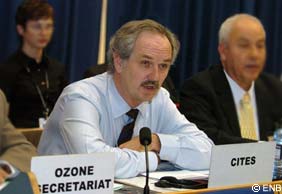|
CITES Secretary-General's Speech to the UNEP Governing Council
23 February 2005
Ladies and gentlemen,
 Synergies and cooperation cannot exist without a continuous exchange of information and a high degree of transparency regarding what goes on in our different yet common areas of activity. Synergies and cooperation cannot exist without a continuous exchange of information and a high degree of transparency regarding what goes on in our different yet common areas of activity.
I am therefore grateful for this opportunity to share some information with you about a number of major developments in the context of the Convention on International Trade in Endangered Species of Wild Fauna and Flora (CITES). They mainly concern the expanding role of the Convention in the broader area of nature conservation and the non-detrimental exploitation of wild animals and plants.
You will all be aware of the very successful meeting of the Conference of the Parties to CITES that was held in Bangkok in October last year.
Apart from the many strictly wildlife-trade-related issues, which of course formed a major part of the discussions and results, it is significant for the development of the Convention that the Parties also discussed the role of CITES in wider issues, such as access to genetic resources and benefit sharing and sustainable use of biodiversity.
This has clearly led to much broader opportunities for synergies with other Conventions as well as with UNEP activities in the area of nature conservation. For example, the Addis Ababa principles and guidelines for the sustainable use of biodiversity, adopted at CoP7 of the Convention on Biological Diversity, were not only welcomed by CITES Parties at CoP13 but also recommended for use by Parties in making scientific decisions on wildlife trade.
An important decision was taken on the further development of and reporting on a joint work programme with the Convention on Migratory Species, particularly on a number of species that are protected under both Conventions, such as the saiga, the snow leopard, Central African elephant populations, marine turtles, whales and sturgeons.
The UNEP and UNESCO-led Great Apes Survival Project, initiated at the WSSD, found strong support in a CITES Resolution recommending inter alia that its Parties adopt and implement comprehensive legislation to protect great apes and to prohibit all international in them as well as national trade for primarily commercial purposes.
Other decisions that will involve close cooperation with other conventions, as well as with UNEP and IUCN, concern the issue of alien invasive species and that of bushmeat.
It is further very encouraging to see that other large international bodies are now cooperating very actively with CITES at the practical level, for example the ITTO on tropical woods (ramin and mahogany) and the FAO on sturgeon harvesting and the trade in caviar. This relatively new involvement of CITES in trade in economically important natural resources shows that the earlier reservations about the role CITES should play in the areas of timber and fisheries have to a large extent disappeared. This is no doubt due to the fact that, in its 30-years of existence, CITES has become a multilateral legal instrument with widespread support, not least from its 167 Parties and the NGO community. CITES further has a unique and strong track record of delivering changes based on a robust enforcement and compliance regime, which includes trade measures, such as suspensions of trade with Parties after unsuccessful attempts to assist in removing causes of illegal trade, non-compliance and/or non-reporting.
Mr Chairman, the CITES Secretariat will continue and step up its efforts to increase the level of cooperation not only with other conventions but also with relevant divisions of UNEP on matters of great importance to us all, such as capacity building, compliance and enforcement, economic instruments and economic incentives. The latter issue has by the way led to important collaboration between CITES and UNCTAD's Biotrade Initiative, for which I am grateful to my colleagues in UNCTAD.
The CITES Conference of the Parties earlier approved a suggestion from the Secretariat to explore, with the Executive Director of UNEP, ways to involve UNEP's regional offices and regional seas conventions' secretariats in regional activities related to, inter alia, capacity building in the area of wildlife trade and biodiversity issues in general. Talks on this are ongoing.
Ladies and gentlemen, with the help of UNEP and in close collaboration with other Conventions and organizations, CITES can and will deliver, but greater consideration should be given urgently by our common constituency to the insufficient - and in the case of CITES even decreasing - level of funding for the ever increasing task we are expected to fulfil. If CITES and other biodiversity-related conventions are to contribute effectively to achieving a significant reduction of biodiversity loss by 2010, it will not be sufficient for the Parties to conventions and their secretariats to find and create common ground for action and joint working programmes, which of course we will continue to do energetically. Equally important, if not more important, is that more financial resources need to be mobilized to actually carry out such actions and programmes.
I am aware that this plea is a rather old song but this meeting is one of the best places to sing it and I hope I did not sing out of tune.
Thank you very much for your kind attention.
|